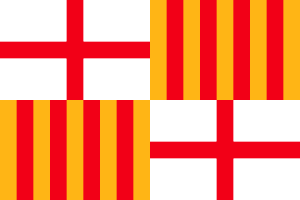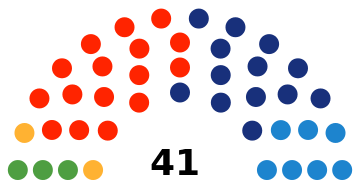Barcelona City Council election, 1995

|
|
|
|
All 41 seats in the Barcelona City Council
21 seats needed for a majority |
| Opinion polls |
| Registered |
1,368,148  0.9% 0.9% |
| Turnout |
906,038 (66.2%)
 10.7 pp 10.7 pp |
| |
First party |
Second party |
Third party |
| |
.jpg) |
.jpg) |
 |
| Leader |
Pasqual Maragall |
Miquel Roca |
Enrique Lacalle |
| Party |
PSC |
CiU |
PPC |
| Leader since |
2 December 1982 |
7 July 1994 |
1987 |
| Last election |
20 seats, 42.9% |
16 seats, 34.1% |
4 seats, 9.8% |
| Seats won |
16 |
13 |
7 |
| Seat change |
 4 4 |
 3 3 |
 3 3 |
| Popular vote |
347,083 |
276,276 |
150,284 |
| Percentage |
38.4% |
30.6% |
16.6% |
| Swing |
 4.5 pp 4.5 pp |
 3.5 pp 3.5 pp |
 6.8 pp 6.8 pp |
|
| |
Fourth party |
Fifth party |
| |
 |
 |
| Leader |
Eulàlia Vintró |
Pilar Rahola |
| Party |
IC |
ERC |
| Leader since |
1987 |
11 March 1995 |
| Last election |
3 seats, 6.4% |
0 seats, 2.6% |
| Seats won |
3 |
2 |
| Seat change |
±0 |
 2 2 |
| Popular vote |
68,813 |
46,272 |
| Percentage |
7.6% |
5.1% |
| Swing |
 1.2 pp 1.2 pp |
 2.5 pp 2.5 pp |
|
|
|
The 1995 Barcelona City Council election was held on Sunday, 28 May 1995, to elect the 5th Barcelona City Council, the unicameral local legislature of the municipality of Barcelona. At stake were all seats in the City Council, determining the Mayor of Barcelona. The number of members decreased from 43 to 41 compared to the previous election.
The unveiling of numerous corruption scandals throughout 1994 affecting Felipe González's Socialist government marked the electoral campaign. For the first time in 16 years, a real possibility for change in the local government resulted in a heated race between Socialists' Party of Catalonia (PSC) candidate and incumbent Mayor Pasqual Maragall and Convergence and Union (CiU) candidate Miquel Roca. Another factors influencing the political debate were the People's Party (PP) rise in opinion polls as well as Republican Left of Catalonia (ERC) recovery.
The election resulted in a surprising comfortable win for PSC and Pasqual Maragall, which was elected for a fourth consecutive term in office with 16 seats and 38.4%. On the other hand, CiU suffered from the PP growth and obtained its worst result since 1983, winning 13 seats and 30.6%. The People's Party nearly doubled its 1991 result with 7 seats and 16.6%, while both Initiative for Catalonia (IC) and ERC improved their electoral performances, with the latter narrowly surpassing the 5% threshold to enter the City Council.
Electoral system
The number of seats in the Barcelona City Council was determined by the population count. According to the municipal electoral law, the population-seat relationship on each municipality was to be established on the following scale:
| Inhabitants |
Seats |
| <250 |
5 |
| 251–1,000 |
7 |
| 1,001–2,000 |
9 |
| 2,001–5,000 |
11 |
| 5,001–10,000 |
13 |
| 10,001–20,000 |
17 |
| 20,001–50,000 |
21 |
| 50,001–100,000 |
25 |
Additionally, for populations greater than 100,000, 1 seat was to be added per each 100,000 inhabitants or fraction, according to the most updated census data, and adding 1 more seat if the resulting seat count gives an even number. As the updated population census for the 1995 election was 1,630,867, the Barcelona City Council size was set to 41 seats.
All City Council members were elected in a single multi-member district, consisting of the Barcelona municipality, using the D'Hondt method and a closed-list proportional representation system. Voting was on the basis of universal suffrage in a secret ballot. Only lists polling above 5% of valid votes in all of the municipality (which include blank ballots—for none of the above) were entitled to enter the seat distribution.
The Spanish municipal electoral law established a clause stating that, if no candidate was to gather an absolute majority of votes to be elected as mayor of a municipality, the candidate of the most-voted party would be automatically elected to the post.[1]
Opinion polls
Vote
Poll results are listed in the table below in reverse chronological order, showing the most recent first, and using the date the survey's fieldwork was done, as opposed to the date of publication. If such date is unknown, the date of publication is given instead. The highest percentage figure in each polling survey is displayed in bold, and the background shaded in the leading party's colour. In the instance that there is a tie, then no figure is shaded. The lead column on the right shows the percentage-point difference between the two parties with the highest figures. When a specific poll does not show a data figure for a party, the party's cell corresponding to that poll is shown empty.
| Date |
Polling Firm/Source |
PSC |
CiU |
PPC |
ICV |
ERC |
Others |
Lead |
|
|
|
|
|
| 28 May 1995 |
Municipal Election |
38.4 |
30.6 |
16.6 |
7.6 |
5.1 |
1.7 |
7.8 |
| Exit polls |
| 18–19 May |
Vox Pública |
34.2 |
32.0 |
15.2 |
10.2 |
4.4 |
4.0 |
2.2 |
| 17 May |
Opina |
37.9 |
35.3 |
11.1 |
8.8 |
4.0 |
2.9 |
2.6 |
| 18 Apr |
Opina |
38.0 |
40.0 |
8.5 |
7.0 |
5.0 |
1.5 |
2.0 |
| 29–30 Mar |
Vox Pública |
31.9 |
37.6 |
13.1 |
8.8 |
4.5 |
4.1 |
5.7 |
| 1995 |
| 12–13 Dec |
Opina |
38.1 |
39.3 |
9.8 |
7.8 |
5.0 |
0.0 |
1.2 |
| 6 Nov |
Avui |
34.8 |
35.8 |
|
|
|
29.4 |
1.0 |
| 1994 |
| 1993 |
| 1992 |
| 26 May 1991 |
Municipal Election |
42.9 |
34.1 |
9.8 |
6.4 |
2.6 |
4.2 |
8.8 |
Seats
Opinion polls showing seat projections are displayed in the table below. The highest seat figures in each polling survey have their background shaded in the leading party's colour. In the instance that there is a tie, then no figure is shaded. 68 seats were required for an absolute majority in the Parliament of Catalonia.
Results
| Parties with less than 0.1% of the vote |
2,472 |
0.27 |
– |
0 |
±0 |
|
Revolutionary Workers' Party (POR) |
726 | 0.08 |  0.01 0.01 |
0 | ±0 |
|
Civic Platform-New Socialist Party (PC-NPS) |
571 | 0.06 | New |
0 | ±0 |
|
Workers' Revolutionary Party (PRT) |
376 | 0.04 |  0.13 0.13 |
0 | ±0 |
|
Spain Independents' Platform (PIE) |
320 | 0.04 | New |
0 | ±0 |
|
Humanist Platform (PH) |
298 | 0.03 | New |
0 | ±0 |
|
European National State (N) |
181 | 0.02 | New |
0 | ±0 |
|
Blank ballots |
8,263 | 0.91 |  0.01 0.01 |
|
| |
| Total |
904,023 | 100.00 | |
41 |  2 2 |
| |
| Valid votes |
904,023 | 99.78 |  0.08 0.08 |
|
| Invalid votes |
2,015 | 0.22 |  0.08 0.08 |
| Votes cast / turnout |
906,038 | 66.22 |  10.71 10.71 |
| Abstentions |
462,110 | 33.78 |  10.71 10.71 |
| Registered voters |
1,368,148 | |
| |
| Source: Ministry of the Interior |
| Vote share |
|---|
|
|
|
|
|
| PSC-PSOE |
|
38.39% |
| CiU |
|
30.56% |
| PPC |
|
16.62% |
| IC-EV |
|
7.61% |
| ERC |
|
5.12% |
| Others |
|
0.78% |
| Blank ballots |
|
0.91% |
| City council seats |
|---|
|
|
|
|
|
| PSC-PSOE |
|
39.00% |
| CiU |
|
31.71% |
| PPC |
|
17.07% |
| IC-EV |
|
7.32% |
| ERC |
|
4.88% |
References

.jpg)
.jpg)

